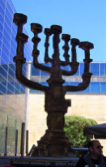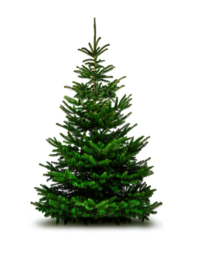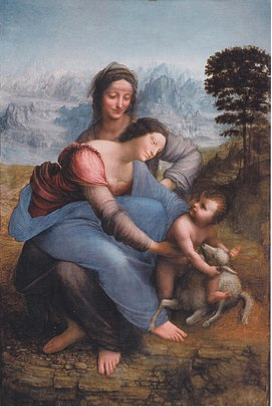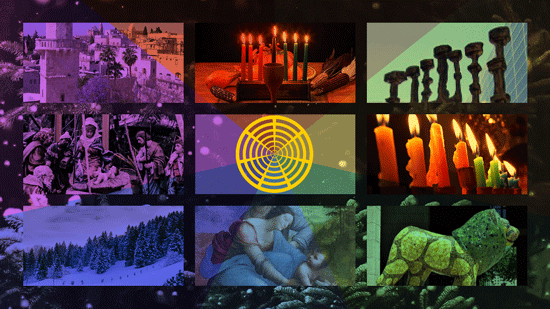Winter Festival of Lights
Presented December 15, 2023 at the Portland Subud House
Assembled by Fayra Teeters
As a theatre-worker/devotee, I’ve reveled in the cooperative nature of theatre my whole life. It takes a village to rehearse and perform any public piece. I often experience performing as an act of worship, similar to the Latihan – so why not bring this sense of theatrical sharing into the sphere of religious, spiritual, and cultural celebration? This is an initial undertaking of blending the traditions prevalent at this time of year, offered to all Subud USA members – feel free to use whatever of this “script” that resonates for your own celebrations.
All the religions and cultures of the world have dealt with mankind’s drooping sense of worth during the darkest days of Winter – largely by lighting candles, oil lamps, Yule logs, bonfires, and offering ceremonies, rituals and celebrations that lift the spirit and shine light into the darkness.
The ancient walled city of Old Jerusalem is divided into four quarters: Jewish, Christian, Muslim and Armenian – all very distinct in their individual cultures, yet blending into each other, due to their close proximity within the one square mile of space that they share. That is the inspiration for this blended ceremony.
In light of the current war in the Middle East, let us open with an Islamic Prayer for Peace:
Almighty Allah, call upon all of your people to care for one another and to respect their differences. Send your Spirit of Wisdom and Peace upon the people of the Holy Land. Help us to bring an end to violence with an acceptance of true justice in the homeland of those who have lost their homes and loved ones. May Your Compassion become the mainstay of life. Amen.
Jewish Quarter – Eighth Night of Hanukkah – Dedication – December 15th
Hanukkah initially celebrated one of the few military victories Israel had over its unending line of conquerors. Alexander the Great  conquered all of the Middle East and wisely allowed the Jews to keep their own culture and religion, but by the time Greek rule passed down to Antiochus IV, that wisdom was no longer in place. Antiochus forced Greek culture and the Greek gods upon Israel as a means of wiping out Jewish culture to assure his absolute control.
conquered all of the Middle East and wisely allowed the Jews to keep their own culture and religion, but by the time Greek rule passed down to Antiochus IV, that wisdom was no longer in place. Antiochus forced Greek culture and the Greek gods upon Israel as a means of wiping out Jewish culture to assure his absolute control.
In 164 BC the Hasmonaean family led by Judah Maccabee rebelled against him. Maccabee means hammer in Hebrew. After the defeat, when Judah entered the Temple, he found only a small jar of oil that had not been defiled by Antiochus. Although there was only enough oil to burn for one night, miraculously, it lasted the full eight nights that it took to consecrate more.
The Hanukkiah or Menorah has 9 branches for the 8 days of celebration: one candle lit each night from left to right, lighting the central candle first, the Shamash or Servitor – because those who serve the community are the very center of its existence. The Menorah symbolizes the Tree of Life, with each of its seven branches topped by little nests that hold seven candles. At the base of the traditional Menorah is a lion, guarding and protecting the people of Israel.
The prayer is sung: Baruch Atah Adonai Elohaynu Melech ha-olam, asher kid’shanu b’mitzvotov, vitzivhnu l’hadlik nayr shel Hanukkah.
Blessed art thou, Eternal our God, King of the Universe, who has protected us and brought us to this day, sanctified us through thy commandments, and instructed us to light the Hanukkah candles.
Pagan Quarter – The Yuletide Winter Solstice – Thursday, December 21st
This is the darkest time of the year, which is why we light the yule log, to shine light into the darkness. (Light the candle and chant/sing:)
May the Yule log burn to light up the night
May all good enter here
May there be grain for bread and vats full of wine
Long before the birth of Christ, the Romans celebrated the Saturnalia on Dec 25 th as well as the birthday of Mithra, the son of Apollo the God of Sun, by feasting with their families for twelve days and giving gifts.
Bringing in a live tree and decorating it with natural things dates back to pre-Christian times in Northern Europe. O Tannenbaum originated as a German pagan folksong:
O Tannenbaum, O Tannenbaum, your branches green delight us
O Tannenbaum, O Tannenbaum, your branches green delight us
You do not fade in Winter’s snow.
You bloom with light when cold winds blow.
O Tannenbaum, O Tannenbaum, how brightly shine your branches
Christian Quarter – Birth of Christ, December 25th
The angel Gabriel was sent to Nazareth, a city in Galilee, to the Virgin Mary, betrothed to Joseph of the house of David. And he came to her and said, “Hail, O favored one, the Lord is with you. You have found favor with God, and behold you will conceive and bear a son, and you shall call his name Jesus. Mary said, “Behold, I am the handmaid of the Lord; let it be to me according to your word.” And the angel departed from her. A decree went out from Caesar Augustus that all should be enrolled in a census, each to his own city. Joseph went up from Galilee to the City of David called Bethlehem, because he was of the house of David, with his betrothed Mary who was with child. While they were there the time came for her to be delivered. She gave birth to her first-born son, wrapped him in swaddling cloths, and laid him in a manger, because there was no place for them in the inn.
Sing 1st verse of Silent Night
Silent Night, Holy Night, all is calm, all is bright
Round yon Virgin mother and child
Holy infant so tender and mild
Sleep in Heavenly Peace; Sleep in Heavenly Peace.
Note: Morris will retell the story of the writing of this carol in 1816 in Austria when the church organ broke down, the pastor wrote Silent Night to be accompanied by guitar.
Now when Jesus was born in the time of Herod, wise men from the East came to Jerusalem saying, “Where is he who is born King of the Jews? We have seen his star in the East and have come to worship him.”
Sing 1st verse of We Three Kings of Orient Are:
We three kings of orient are bearing gifts we’ve traversed afar
Field and fountain, moor and mountain, following yonder star.
Oh – star of wonder, star of light, star with royal beauty bright
Westward leading still proceeding, guide us to thy perfect light.
When Herod heard this, he was troubled and summoned the wise men secretly saying, “Go and search for the child and when you have found him bring me word that I too may come and worship him.” The Wise Men went their way and the star which they had seen went before them till it came to rest over the manger where the Child was. When they saw the Child with Mary, they fell down and worshipped him, offering their treasures of gold, frankincense and myrrh. Being warned in a dream not to return to Herod, they departed by another way. An angel of the Lord appeared to Joseph and said, “Flee to Egypt with the Child and Mary and remain there until I tell you, for Herod is coming to destroy the Child.” And Joseph departed by night and remained in Egypt until the death of Herod.
African-American Quarter – Kwanzaa – December 26-January 1st
Kwanzaa was created by Dr. Maulana Karenga in 1966 as a holiday to bring Black people together. He drew largely from Hanukkah as a religious ceremony centered in the home, and African First Fruit Festivals that celebrated the Harvest allowing people to give thanks to their Creator, while honoring their ancestors. He set this seven-day holiday to begin the day after Christmas to distance it from the commerciality of the American Xmas Season.

Let us now light the candles in honor of the Nguzo Saba: the seven principles of Kwanzaa:
Umoja (oo-MOH-jah) the central black candle means Unity within our family and community.
Kujichagulia (koo-jee-chah-goo-LEE-ah) the first green candle on the left, meaning Self-Determination, creating our own destinies, taking personal responsibility.
Ujima (oo-JEE-mah) the first red candle on the right, meaning Collective Work to bring our community together.
Ujamaa (oo-jah-MAH) the second green candle on the left, meaning Collective Enterprises to build and support enterprises within our community.
Nia (NEE-ah) the second red candle on the right, meaning Purpose to restore our people to greatness.
Kuumba (koo-OOM-bah) the third green candle on the left, meaning Creativity to use cultural inspiration to improve our community.
Imani (ee-MAH-nee) the third red candle on the right, meaning Faith in God our Creator, in our leaders, in our people to do the right thing.
(Presenter lifts Communal Cup of Liberty, saying) “We now honor our ancestors for planting seeds of renewal in our bodies, minds, hearts, and souls. Bless all who are present with a productive and fertile coming year; and bless all our friends and family members who are not at this gathering.”
Everyone drinks from their own cup; presenter pours the last of her cup into a potted plant on the floor, saying:
“We dedicate this last portion to our loved ones no longer with us – may they exalt eternally in Spirit!” Everyone replies “Amen!”
We close with Morris McClellan’s song Let Peace Prevail:
The earth is home for everyone,
A planet jewel, warmed by the sun,
Stranger and friend, reach out your hand,
Lift up your voices, and make a stand
Lift up your voices, throughout every land
Chorus: Let peace prevail, o’re mountains tall,
Through hill and dale, for one and all,
‘Cross oceans wide, love shall not fail,
Throughout the world, Let Peace Prevail.
Throughout the world, Let Peace Prevail.
With each breath, let our hope renew,
For in each heart the beat is true
Our trust in love will tell the tale,
So trust in love, let peace prevail
So trust in love, let peace prevail
Chorus: Let peace prevail, o’r mountains tall, through hill and dale, for one and all,
‘Cross oceans wide, love shall not fail, throughout the world, Let Peace Prevail.
Throughout the world, Let Peace Prevail. (Repeats)
Thru-out the world, Thru-out the world, Thru-out the world, Thru-out the world
Let Peace Prevail, Let Peace Prevail, Thru-out the world, Let Peace Prevail.

